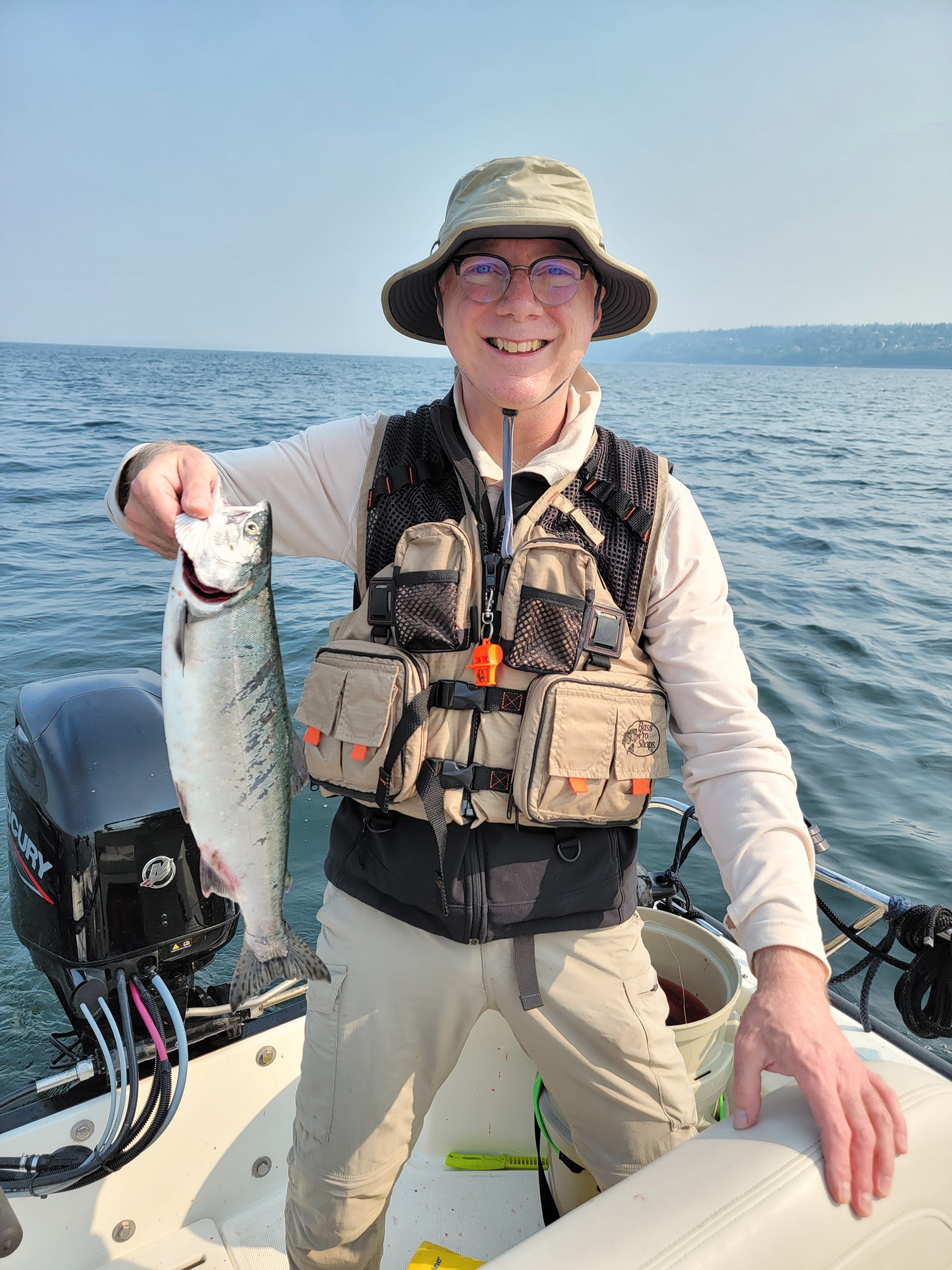Today was my friend Dave’s turn to catch some pink salmon. We put in about 8:30 and headed south towards our fishing grounds. We weren’t going to let a little forest fire smoke scare us away. Pinks only run every two years, and they are an excellent way to practice for the more challenging fish.
One thing I learned in my recent fishing class was to be intentional about the direction I troll in. The first time I tried downrigger fishing, I would just troll around randomly with poor results. I learned that you cannot troll against the current. Fish like to approach your lure from behind, and when they see a downrigger ball coming at them they just swim out of the way. This means you need to plan out your trolling drift before you ever get in the water.
Tidal currents are one reason why Puget Sound is such an interesting environment to boat and fish in. Puget Sound, like the rest of the Salish Sea, is essentially a big bowl that fills and partially drains twice each day with the tide. The tides create currents, which start in the Strait of Juan de Fuca and then fan out through all the region’s waterways. All the islands and inlets in our complex geography function like rocks in a river, funneling these currents through narrow passages. Some, like through Deception Pass, can be quite extreme. If you’re astute enough, you can estimate the effect of these currents in your fishing area by studying the nautical chart and the tide tables. However, there is now an app which can figure that out for you.
Since this morning we would be on a flood tide (incoming current), the app predicted that the current would be about 0.4 mph northward. Based on that, I planned to start our drift at the Mukilteo Shipwreck and troll northward towards the lighthouse. We arrived there a little after 9:00 and set up our gear. Dave has a knack for making my kicker motor work, and it started for him on the first pull. Our fishing, though, got off to a rocky start. Although we got our first bite within minutes, we lost that fish when we failed to net it. Another fish on my side of the boat managed to slip off the hook (in Puget Sound all anglers are required to use barbless hooks). About the same time, Dave started fighting a particularly cantankerous fish on his side when his line suddenly snapped. It’s always a bad feeling knowing that not only have you lost your fish and gear, but you’ve also littered Puget Sound and left some poor fish with all of your tackle hooked to its mouth.
After that commotion, I went to reset the downrigger on my side and realized that I never brought the ball back up after that last fish I lost. As I cranked it up to the surface, I told Dave that I found both his gear and his fish – It was all tangled up in a big mess on my downrigger line! The fish had apparently swam under the boat while Dave was fighting it, got the gear snagged on the downrigger on the other side, and ensnared himself in the mess. Such was our first catch of the day. After that, it took a fair bit of time to untangle the mess, tie a new termination on Dave’s rod, and reset all our gear. Once all that was done, though, the fish started coming aboard regularly and we had our limit of four by 10:30… Just 15 minutes later than last weekend.
Expecting that we might limit early like last week, I planned for us both to bring along a second rod rigged with a spinning reel to practice catch-and-release jigging. Jigging is the old-fashioned way to catch salmon, and it’s what people who fish from shore typically do. You use a special sliding lure such as a Buzz Bomb, cast it some distance from the boat, and jig it sharply upwards at regular intervals. Dave has a lot of experience using this type of fishing to catch trout in freshwater lakes. He immediately figured it out, and had a field day for the next hour. He caught four, one of which escaped on its own, and three of which we released. During that time I caught none, but it was fun to learn from the master. Dave don’t need no stinking downrigger!


It had been a very active day of fishing, and I never even had time to pull up my fish finder. After getting skunked at Baker Lake, it was nice to come home with a full kill bag. When we were done, we realized that we had never drifted far from the shipwreck all morning. The app had been wrong. We suspected it was because the wind had been blowing us south while the current blew us north, and they canceled each other out. Every day of fishing is a new opportunity to study nature.
Fishing is a brutal business; you must kill the fish to eat it. It’s important to bleed it out right away, so that the blood doesn’t ruin the taste of the meat. The boat can start to look like a gruesome crime scene, especially when your fishing buddy is a little overzealous with the murder weapon. I can certainly understand the Native American way of thanking the fish for its sacrifice. This magnificent wild creature has spent the last two years swimming thousands of miles around the Pacific, only to be killed by me on its way back to spawn. With four million pinks in this year’s run though, I will partake of the feast.
Discover more from Mini Montauk Adventures
Subscribe to get the latest posts sent to your email.


